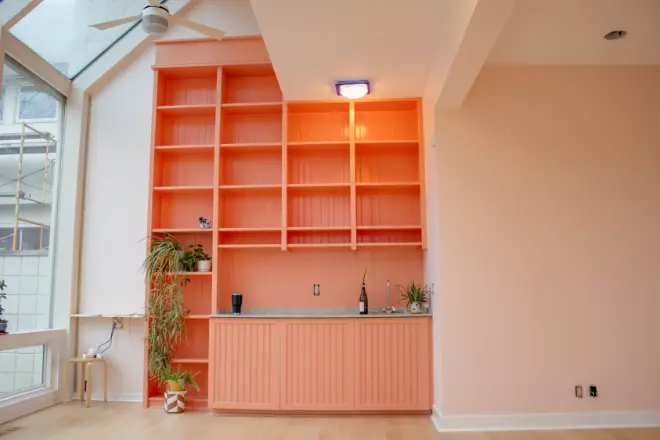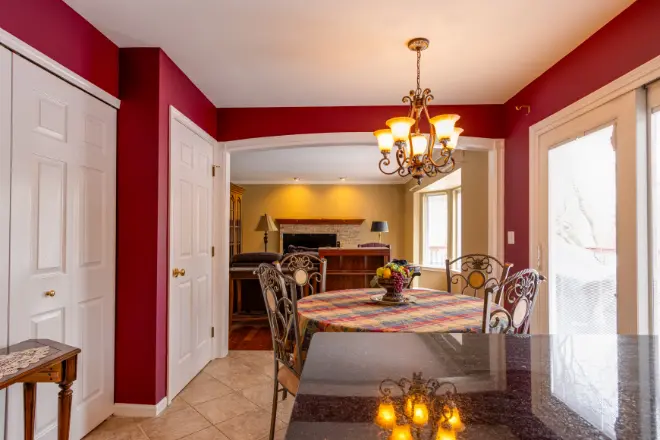Key Points
- Gloss paint reflects more light and offers superior durability, making it ideal for trim, kitchens, and bathrooms.
- Satin paint provides a soft sheen that hides imperfections and works best in living rooms, bedrooms, and hallways.
- Choose gloss for high-traffic, cleanable areas; choose satin for a subtle finish and easier application.
Shine On or Subtle Down? Sheen Secrets You Need to Know
Wondering why your walls don’t look quite right even after choosing the perfect color?
Not sure if that glossy trim is too shiny—or just right?
In this blog post, we’re breaking down satin vs. gloss—two of the most popular paint finishes—and showing you how each one performs when it comes to durability, light reflection, cleanability, and overall look.
By the end, you’ll know exactly which finish works best in different rooms, how to apply it properly, and how to avoid costly interior painting mistakes.
And if you’d rather skip the guesswork, Tribble Painting Company is just a phone call or contact form away—we’re always here to help Michigan homeowners get the finish just right.
Satin vs. Gloss: What’s the Real Difference?
Understanding the difference between satin vs. gloss is key to choosing the right paint finish for your Ann Arbor home.
These two popular finishes not only look different—they perform differently too.
Sheen and Light Reflectivity
The most noticeable contrast between satin and gloss lies in how they handle light:
- Satin paint has a soft, subtle sheen. It reflects just enough light to give your walls a gentle glow without creating glare.
- Gloss paint has a bold shine. It reflects much more light, making it ideal for spaces where you want a high shine finish or more visual impact.
Satin and gloss may also appear differently under natural vs artificial lighting—a key factor when painting rooms with limited sunlight.
Texture and Feel
- Satin finish feels smooth and soft, almost like silk when dry.
- Gloss finish is slick and hard to the touch—ideal for areas that get cleaned often or need a more durable finish.
Coverage and Application Differences
- Satin paint is more forgiving and can hide imperfections like minor dings or uneven spots.
- Gloss paint finish will highlight every flaw, bump, or roller mark, so it demands a near-perfect surface.
DIYers in Ann Arbor may find satin easier to apply, while gloss takes more prep and precision for a polished look.
What Are the Pros and Cons of Satin Paint?
Thinking about using satin paint in your next painting project?
Here’s what you should know.
Benefits of Satin Finish
- Offers a smooth finish with a soft, aesthetic appeal that works well in living rooms, dining rooms, and bedrooms.
- Helps hide imperfections, making it easier to refresh older walls without heavy prep work.
- Easier to touch up than glossier options.
- Great for high traffic areas where you want durability without too much shine.
Drawbacks of Satin Finish
- It is not as hard-wearing or moisture-resistant as gloss paint, so it’s less ideal for bathrooms or kitchens.
- Can show brush marks or roller overlap if not applied evenly.
- Over time, satin may dull faster than gloss, especially in areas that require frequent cleaning.
What Are the Pros and Cons of Gloss Paint?

Gloss paint stands out for its sleek, bold finish—but it’s not right for every room in your home.
Let’s break down the benefits and drawbacks of choosing a gloss finish.
Benefits of Gloss Finish
- Creates a shiny finish that helps reflect light, brightening up dark corners or compact spaces.
- One of the most durable paint finishes—ideal for high traffic areas, like hallways or trim that sees frequent wear.
- Stands up well to repeated cleaning, making it a top choice for doors, baseboards, and cabinets in kitchens or bathrooms.
- A gloss paint finish can also add visual contrast when paired with a satin or matte wall color.
Drawbacks of Gloss Finish
- It reveals every flaw. From dents and scratches to uneven brushwork, gloss magnifies imperfections.
- Requires a well-prepped surface—you may need to sand and prime first.
- Its reflective surface can feel too intense in relaxed spaces like bedrooms or living rooms.
- In some settings, the shine can appear dated or overly industrial if not balanced with softer paint finishes.
Satin vs. Gloss: Durability and Cleanability
When comparing satin vs. gloss, knowing how each finish handles everyday wear and tear can help you make a more informed decision.
- Gloss paint is a clear winner when it comes to toughness. It’s highly resistant to scuffs, moisture, and frequent scrubbing—making it the best choice for areas exposed to grime or fingerprints.
- Satin paint, while still fairly durable, is better suited for areas that need gentle cleaning rather than full-on scrubbing.
Which Is Easier to Maintain Over Time?
- Gloss holds up better in the long run. If you have kids, pets, or a bustling household in Ann Arbor, gloss paint on doors and trim will save you time on maintenance.
- Satin, though less prone to showing dust, can lose its soft sheen over time if aggressively cleaned. Regular, light upkeep is best.
Where Should You Use Satin Paint?
Satin paint offers a subtle finish with just enough sheen to catch the eye—without overpowering a room’s look.
It’s one of the most popular finishes for good reason.
Ideal Interior Applications
- Painting a living room or dining room with satin’s smooth, low-glare appearance makes the walls easy to wipe clean.
- Painting a bedroom with satin paint adds warmth without the stark shine of gloss.
- Hallways and foyers are a great match too—these high-traffic areas need a durable finish that still hides imperfections.
Exterior Uses
- Great for siding or trim on homes across Ann Arbor that get more light exposure but need to avoid harsh glare.
- A smart choice when you want color depth with a less reflective appearance.
When to Choose Satin Over Gloss
- You want a balance between easy maintenance and a soft look.
- The surface isn’t perfectly smooth, and you’d like to hide imperfections.
- You prefer a quieter, more understated aesthetic appeal for your home’s walls or woodwork.
Where Should You Use Gloss Paint?
Gloss paint is bold, reflective, and built to stand up to wear.
If you’re looking to add a polished look to specific parts of your home, this finish gets the job done.
Best Indoor Applications
- Use it for trim, molding, and doors, where repeated contact calls for easy-clean paint finishes.
- Ideal for kitchens and bathrooms, where moisture and spills are common.
- Want a standout feature? Apply gloss paint to furniture pieces or an accent wall for contrast.
Exterior Applications
- A popular choice for front doors thanks to its high gloss shine and weather resistance.
- Adds definition to wood or detailed exterior trim work.
When to Choose Gloss Over Satin
- The goal is to reflect more light and create a crisp, dramatic effect.
- You want a hard-wearing, durable surface for messy or frequently touched areas.
- You’re okay with prepping the surface carefully for that flawless, smooth result.
How to Decide: Gloss vs Satin for Different Rooms

Choosing the right finish often depends on the function and feel you want in each room of your Ann Arbor home.
Here’s how to narrow it down.
Kitchen and Bathroom Walls
- Gloss or even semi-gloss is ideal—these paint finishes resist moisture and clean up effortlessly.
- Avoid matte or flat paints here—they won’t stand up to steam and splashes.
Bedrooms and Living Rooms
- Satin offers a soft glow that supports a relaxing, cozy atmosphere.
- Its ability to hide imperfections makes it great for older homes or walls with minor flaws.
Trim and Doors
- Go with gloss paint for durability and wipeability.
- For a slightly less intense look, semi-gloss provides a good middle ground with a higher sheen than satin.
Ceilings
- Stick with matte or flat paint here, unless you’re going for a bold, decorative look.
- In rare cases, satin might work if you want a light-reflecting ceiling in a darker room.
Tips for Applying Gloss and Satin Paint
Whether you’re tackling a DIY project or hiring a pro, how you apply your paint finishes makes a big difference in the final look.
Surface Preparation
- Gloss paint demands a smooth, clean surface—even minor imperfections will stand out.
- Sanding and priming are essential for a polished high-gloss or gloss paint finish.
- Satin paint is more forgiving, but you’ll still want to prep for best results.
Best Tools to Use
- Use high-quality brushes or rollers to avoid streaks in both satin and gloss applications.
- Sprayers work especially well for gloss because they reduce visible brush marks.
- Be sure to choose tools that suit your specific paint finishes—check the label or ask at your local paint aisle.
Dry Time and Recoat Considerations
- Gloss takes longer to dry and cure, so be patient between coats.
- Satin usually dries quicker but may need a second coat for full coverage.
- Always follow the manufacturer’s instructions to avoid uneven paint finishes or peeling.
What About Semi-Gloss or Eggshell?
Not quite ready to commit to high gloss or full matte?
Semi-gloss and eggshell finishes offer solid middle-ground options that are worth considering.
The Role of Semi-Gloss
- Offers a paint finish that’s durable and easy to clean—ideal for trim, bathrooms, and kitchens.
- Less reflective than full gloss, but more resilient than satin.
- Great choice when you want a touch of shine without going overboard.
Where Eggshell Fits In
- Sits between matte and satin in terms of sheen.
- Soft and subtle—great for low-traffic areas like adult bedrooms or home offices.
- Not ideal for surfaces exposed to heavy cleaning.
When to Choose These Alternatives
- Semi-gloss works well when you want easy upkeep but a lower shine than gloss paint.
- Eggshell is perfect when you want a gentle, velvety finish that still hides light imperfections.
- Your personal preference and the room’s use will guide the best decision.
Follow the link to learn more about paint sheen differences.
Frequently Asked Questions About Satin and Gloss Paint
Still deciding between satin and gloss?
These quick answers may help you make the right choice for your next painting project in Ann Arbor.
What’s better, satin or gloss?
It depends on where you’re painting and your style goals.
- Gloss is best for areas that need durability and frequent cleaning—like trim, doors, and bathrooms.
- Satin is ideal for larger wall surfaces or rooms where you want a softer, more subtle look.
Think about function first, then paint colors and finish type.
Is satin finish shiny?
Satin paint has a soft, velvety sheen—noticeable but not reflective.
It offers just enough light bounce to brighten a room without creating a glossy look.
What are the disadvantages of satin paint?
It’s not as moisture-resistant as gloss, making it less ideal for kitchens or bathrooms.
If applied too quickly or unevenly, it can show lap marks or subtle streaks.
Gloss or Satin? Let Tribble Painting Company Help You Nail the Perfect Finish
Whether you’re going for a soft, low-sheen look or a bold, reflective finish, understanding the pros and cons of satin and gloss helps you make smarter decisions for each room in your home.
From durability to design, you’ve now got a clear handle on which paint finishes suit different surfaces and situations.
Still not sure which is right for your space?
The experienced interior painters at Tribble Painting Company can guide you through the selection process and deliver a flawless finish tailored to your style.

